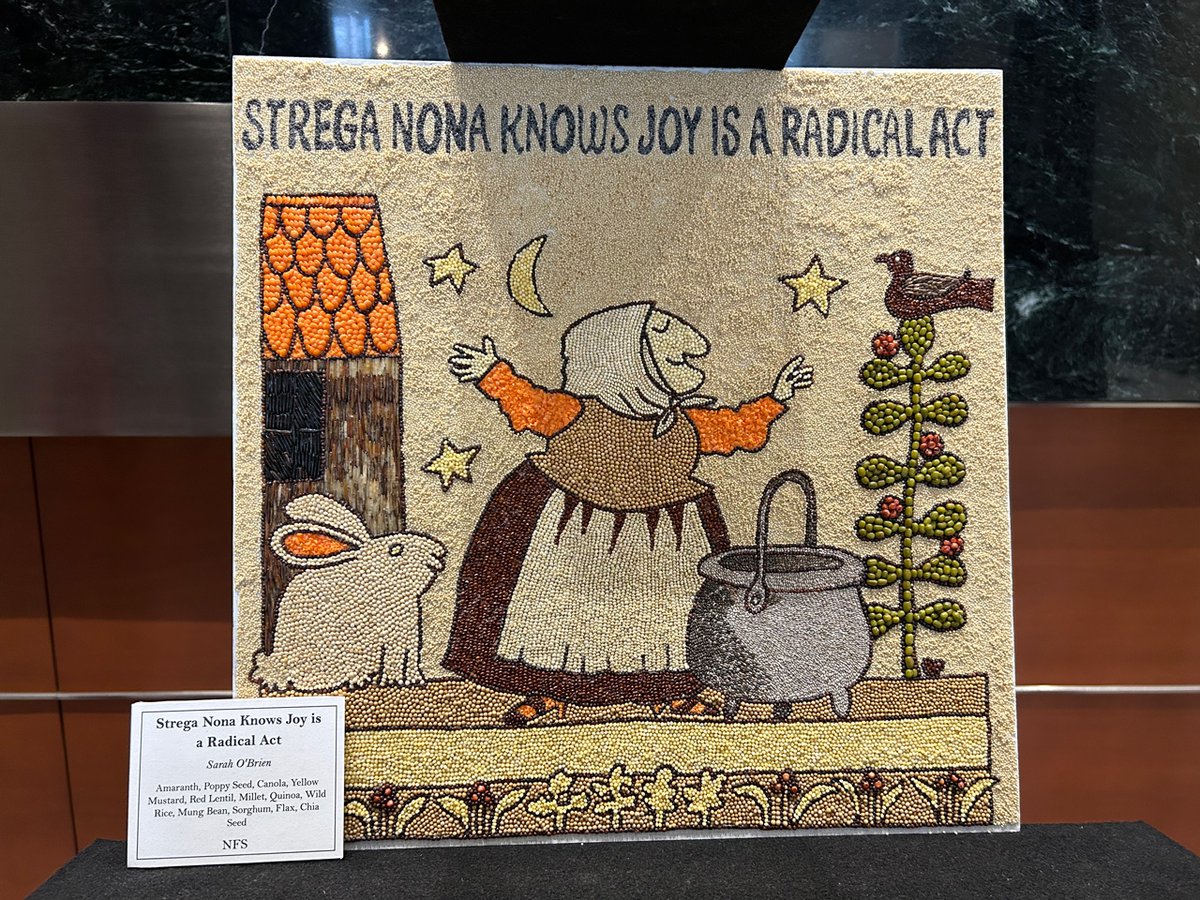
Can’t wait until the Minnesota State Fair to get your crop art fix? Head over to the Diane E. Murphy U.S. Courthouse to check out the Seeds of Justice crop art exhibit. On display until July 31, the collection showcases each artist’s interpretation of justice using seeds as their medium.
“When we had our opening, a lot of people were commenting about having the ability to sit and look more closely, because at the State Fair, it’s so popular that you can’t sit and fully absorb any one piece like you could at a museum,” says crop artist Marta Shore, one of the co-organizers of the exhibit and the assistant superintendent for crop art and scarecrow at the State Fair. “And so this is really fantastic for allowing people to really look at the art and also ponder the meaning.”
Shore worked with crop artist and lawyer Juventino Meza and the U.S. District Court’s public information officer Rebeccah Parks to make this exhibit come to fruition. They put out a call for artists from January to February and collected 17 pieces for the display. Some of the artwork was created specifically for this exhibit, while others were showcased at the State Fair in the past.
One of the artworks on display includes Meza’s piece, which depicts Supreme Court Justice Sonia Sotomayor, who served as a big inspiration for Meza to attend law school. For Meza, creating a crop art portrait of the Supreme Court Justice was a way to honor his idol and his family’s agricultural roots.
Meza utilized red and green beans, sunflower, brown flax, white and red quinoa, dried pepper, and yellow lentils to portray the smiling Justice Sotomayor. It sits in an engraved gold frame, the words “The People’s Justice” spelled out with seeds underneath her name.
But this isn’t his first portrait of Justice Sotomayor. Back in 2023 when he was first making crop art, Meza created a portrait that ended up being too big for the State Fair. What he thought would be a relaxing hobby ended up being everything but that. The process included a scare when his dog ate a bunch of seeds and a trip to the ER when he slashed his knee while making the frame. Despite his piece getting rejected by the State Fair, the crop art community encouraged Meza to tell his story at The Moth storytelling competition in 2024.
“That’s how I started to know people in crop art, and everyone was really nice and supportive,” Meza says. “I also learned that there’s a lot of resources on how to do it, which I didn’t know before. So my advice to any new person to this is there is a whole website with tutorials that you can watch. Don’t be like me.”
Shore has a piece displayed at the exhibit too, which was showcased at the State Fair in 2019 and received an honorable mention. Shore used millet, red corn, wild rice, flax, mung bean, and poppy seeds to write out the phrase: “They Tried To Bury Us, They Didn’t Know We Were Seeds.” The word “Seeds” is depicted as roots underground in soil, with flowers sprouting from the letters above the surface. Shore first discovered the phrase on a sign at a protest.
“I just really liked that message, because not only is it a protest against oppression, but it’s also hope that we can nourish ourselves and we can grow and we can tend to ourselves,” Shore says. “And I thought that fit really well with Seeds of Justice because we have to nurture justice, and we have to grow justice, and part of it is protesting.”
Looking at the work on display, you’ll see what justice means to each of the artists. There are several famous political figures portrayed, from former Minnesota Senator Paul Wellstone to former Supreme Court Justice Thurgood Marshall. Significant political events are cemented in seeds, including the landmark free speech Supreme Court case Tinker v. Des Moines. Even Beyoncé makes an appearance—her iconic Cowboy Carter outfit created with quinoa, sunflower seed kernels, and corn husk.
Not only do the courthouse exhibits showcase talented local artists, but they also help make politics more accessible to people. The Seeds of Justice display invites people into the courthouse and emphasizes that courts are public spaces.
“I was an intern here for two summers, and it was really intimidating to first start coming,” Meza says. “And I think that’s maybe the culture we’ve created around courts. And I think part of this is trying to demystify what courts do and the important role courts play in society. And at the end of the day, they’re public spaces. We the public own these spaces.”
The court is still in the process of figuring out its next public art exhibit, and they’re always looking for partner art organizations and agencies to work with for future installations. When it comes to crop art, the Minneapolis Institute of Art is sponsoring two crop art awards this year: One will be for an interpretation of a well-known fine art piece, and the other for a representation of a Minnesota landmark, story, or tradition. A judging panel will visit the State Fair before it opens to choose the pieces, then the winners will be announced at the start of the fair.
“What I’m really excited about is seeing all these institutions in Minnesota embrace crop art as part of our culture,” Shore says, “even though it’s from humble roots.”
